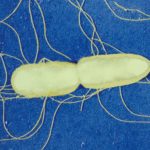Lien vers Pubmed [PMID] – 27555304
MBio 2016;7(4)
UNLABELLED: For 100 years, it has been obvious that Salmonella enterica strains sharing the serotype with the formula 1,4,[5],12:b:1,2-now known as Paratyphi B-can cause diseases ranging from serious systemic infections to self-limiting gastroenteritis. Despite considerable predicted diversity between strains carrying the common Paratyphi B serotype, there remain few methods that subdivide the group into groups that are congruent with their disease phenotypes. Paratyphi B therefore represents one of the canonical examples in Salmonella where serotyping combined with classical microbiological tests fails to provide clinically informative information. Here, we use genomics to provide the first high-resolution view of this serotype, placing it into a wider genomic context of the Salmonella enterica species. These analyses reveal why it has been impossible to subdivide this serotype based upon phenotypic and limited molecular approaches. By examining the genomic data in detail, we are able to identify common features that correlate with strains of clinical importance. The results presented here provide new diagnostic targets, as well as posing important new questions about the basis for the invasive disease phenotype observed in a subset of strains.
IMPORTANCE: Salmonella enterica strains carrying the serotype Paratyphi B have long been known to possess Jekyll and Hyde characteristics; some cause gastroenteritis, while others cause serious invasive disease. Understanding what makes up the population of strains carrying this serotype, as well as the source of their invasive disease, is a 100-year-old puzzle that we address here using genomics. Our analysis provides the first high-resolution view of this serotype, placing strains carrying serotype Paratyphi B into the wider genomic context of the Salmonella enterica species. This work reveals a history of disease dating back to the middle ages, caused by a group of distinct lineages with various abilities to cause invasive disease. By quantifying the key genomic differences between the invasive and noninvasive populations, we are able to identify key virulence-related targets that can form the basis of simple, rapid, point-of-care tests.


